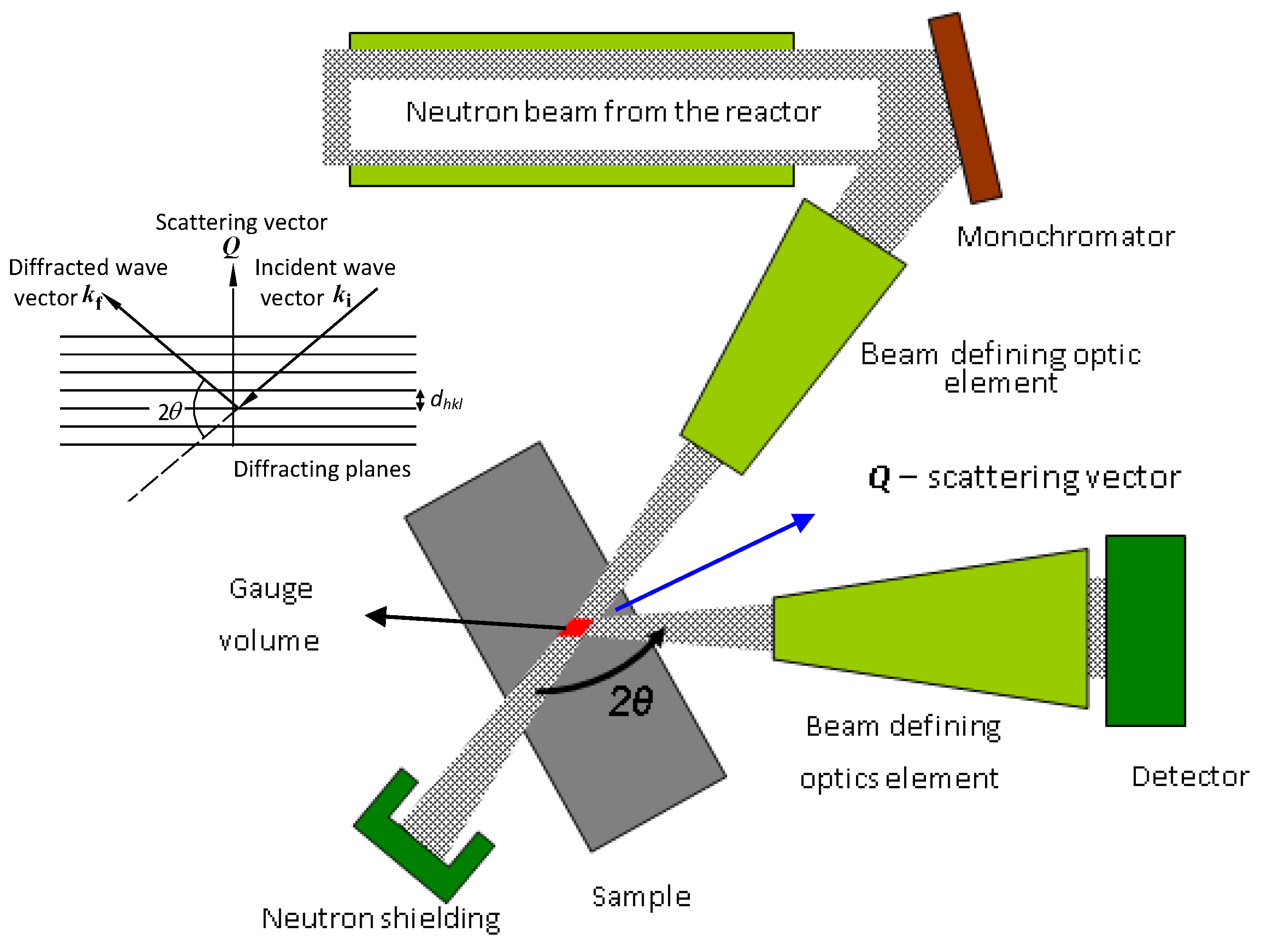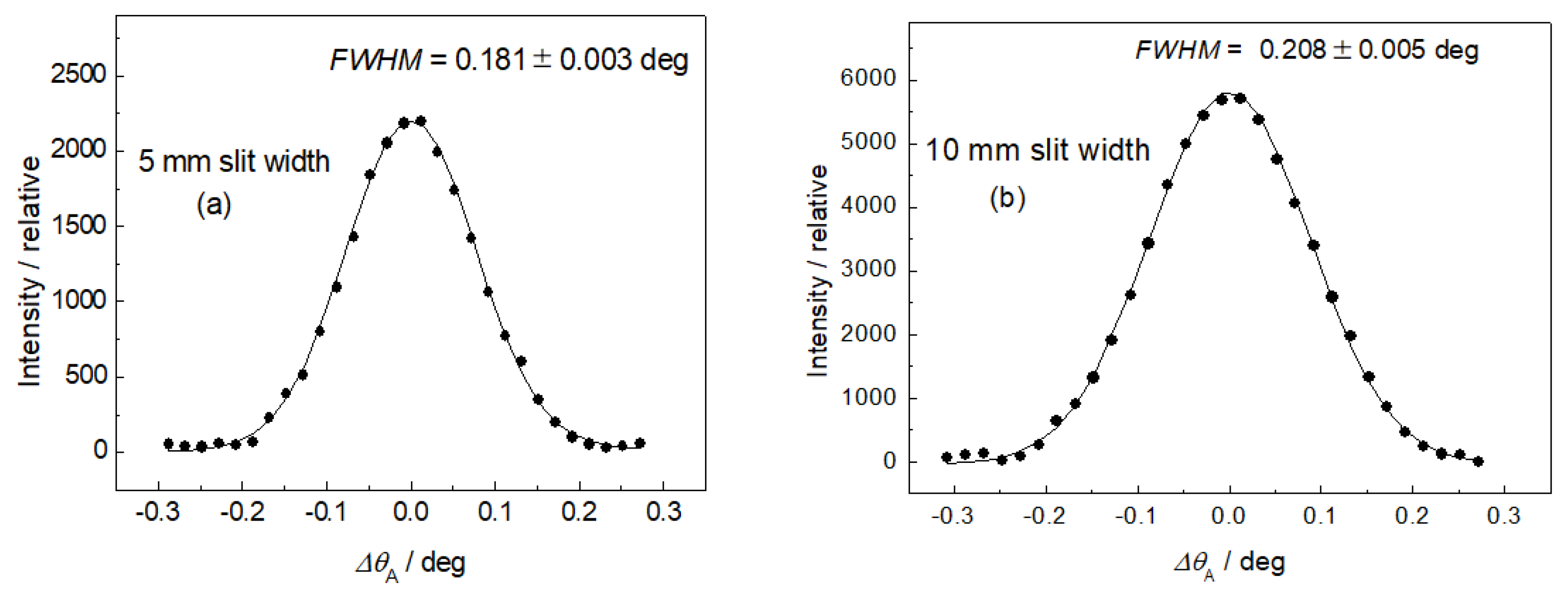High-Resolution Strain/Stress Measurements by Three-Axis Neutron Diffractometer
Abstract
1. Introduction
2. Materials and Methods
3. Results
4. Discussion
5. Conclusions
Author Contributions
Funding
Acknowledgments
Conflicts of Interest
References
- Noyan, I.C.; Cohen, J.B. Residual Stress: Measurement by Diffraction and Interpretation, 1st ed.; Springer: New York, NY, USA, 1987. [Google Scholar]
- Hutchings, M.T.; Krawitz, A.D. Measurement of Residual and Applied Stress Using Neutron Diffraction. In NATO ASI Series; Hutchings, M.T., Krawitz, A.D., Eds.; Kluwer Academic Publisher: Amsterdam, The Netherlands, 1992; Volume 26. [Google Scholar]
- Stelmukh, V.; Edwards, L.; Santisteban, J.R.; Ganguly, S.; Fitzpatrick, M.E. Weld stress mapping using neutron and synchrotron X-ray diffraction. Mater. Sci. Forum 2002, 404–407, 599–604. [Google Scholar] [CrossRef]
- Mikula, P.; Vrána, M.; Lukáš, P.; Šaroun, J.; Wagner, V. High-resolution neutron powder diffractometry on samples of small dimensions. Mater. Sci. Forum 1996, 228–231, 269–274. [Google Scholar] [CrossRef]
- Mikula, P.; Vrána, M.; Lukáš, P.; Šaroun, J.; Strunz, P.; Ullrich, H.J.; Wagner, V. Neutron diffractometer exploiting Bragg diffraction optics—A high resolution strain scanner. In Proceedings of the ICRS-5 Conference, Linköping, Sweden, 16–18 June 1997; Volume 2, pp. 721–725. [Google Scholar]
- Seong, B.S.; Em, V.; Mikula, P.; Šaroun, J.; Kang, M.H. Unconventional performance of a highly luminous strain/stress scanner for high resolution studies. Mater. Sci. Forum 2011, 681, 426–430. [Google Scholar] [CrossRef]
- Mikula, P.; Šaroun, J.; Ryukhtin, V.; Stammers, J. An alternative neutron diffractometer performance for strain/stress measurements. Powder Diffr. 2020, 35, 185–189. [Google Scholar] [CrossRef]
- Vrána, M.; Lukáš, P.; Mikula, P.; Kulda, J. Bragg diffraction optics in high-resolution strain measurements. Nucl. Instrum. Methods Phys. Res. A 1994, 338, 125–131. [Google Scholar] [CrossRef]
- Macek, K.; Lukáš, P.; Janovec, J.; Mikula, P.; Strunz, P.; Vrána, M.; Zaffagnini, M. Austenite content and dislocation density in electron beam welds of a stainless maraging steel. Mater. Sci. Eng. A 1996, 208, 131–138. [Google Scholar] [CrossRef]
- Hirschi, K.; Ceretti, M.; Lukáš, P.; Ji, N.; Braham, C.; Lodini, A. Microstrain measurement in plastically deformed austenitic steel. Textures Microstruct. 1999, 33, 219–230. [Google Scholar] [CrossRef]
- Delhez, R.; de Keijser, T.H.; Mittemeijer, E.J. Determination of crystallite size and lattice distortions through X-ray diffraction line profile analysis. Fresenius’ Z. Anal. Chem. 1982, 312, 1–16. [Google Scholar] [CrossRef]
- Davydov, V.; Lukáš, P.; Strunz, P.; Kužel, R. Single-line diffraction profile analysis method used for evaluation of microstructural parameters in the plain ferritic steel upon tensile straining. Mater. Sci. Forum 2008, 571–572, 181–188. [Google Scholar] [CrossRef]







Publisher’s Note: MDPI stays neutral with regard to jurisdictional claims in published maps and institutional affiliations. |
© 2020 by the authors. Licensee MDPI, Basel, Switzerland. This article is an open access article distributed under the terms and conditions of the Creative Commons Attribution (CC BY) license (http://creativecommons.org/licenses/by/4.0/).
Share and Cite
Mikula, P.; Ryukhtin, V.; Šaroun, J.; Strunz, P. High-Resolution Strain/Stress Measurements by Three-Axis Neutron Diffractometer. Materials 2020, 13, 5449. https://doi.org/10.3390/ma13235449
Mikula P, Ryukhtin V, Šaroun J, Strunz P. High-Resolution Strain/Stress Measurements by Three-Axis Neutron Diffractometer. Materials. 2020; 13(23):5449. https://doi.org/10.3390/ma13235449
Chicago/Turabian StyleMikula, Pavol, Vasyl Ryukhtin, Jan Šaroun, and Pavel Strunz. 2020. "High-Resolution Strain/Stress Measurements by Three-Axis Neutron Diffractometer" Materials 13, no. 23: 5449. https://doi.org/10.3390/ma13235449
APA StyleMikula, P., Ryukhtin, V., Šaroun, J., & Strunz, P. (2020). High-Resolution Strain/Stress Measurements by Three-Axis Neutron Diffractometer. Materials, 13(23), 5449. https://doi.org/10.3390/ma13235449




